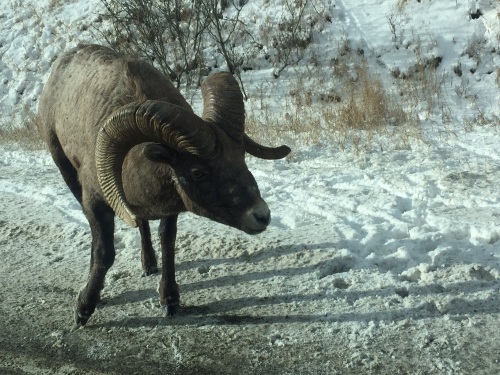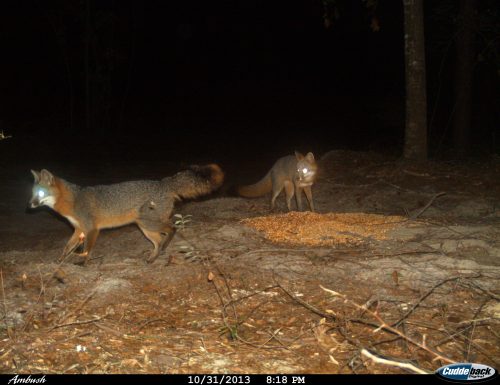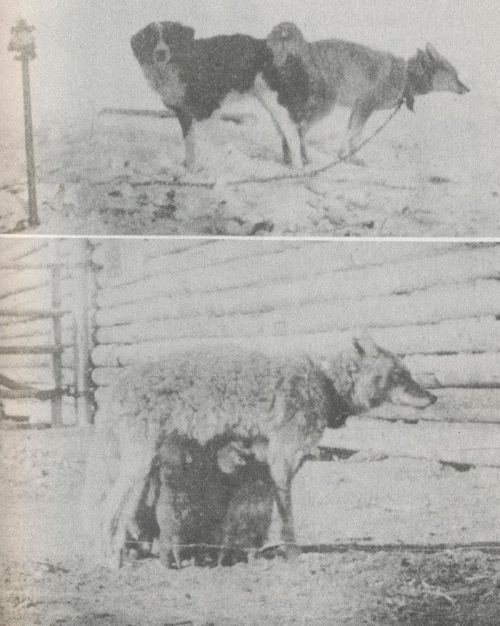I’m a nonbeliever, but this is beautiful:
Posted in Uncategorized on December 25, 2016|
Posted in wolves, tagged David Mech, Jim Brandenburg on December 25, 2016| 1 Comment »
Yep. This has to have been the first documentary about wolves I ever watched. Jim Brandenburg and David Mech hanging out with a wolf pack from a population that has never experienced persecution:
Posted in wildlife, tagged bighorn, bighorn sheep, Wild Sheep on December 22, 2016|
Zech Beard, my sister’s boyfriend, was in Montana a few weeks ago, and he came across these bighorn licking salt along the road, including a pretty nice ram.



We saw a lot of Dall sheep in Alaska, but I didn’t get any photos of them.
So I’m glad Zech let me share these bighorn here.
Posted in wild dogs, tagged gray fox on December 21, 2016| 1 Comment »
Gray foxes will actually come to eat corn set out for other animals. Their dentition is actually much more aligned for an omnivorous diet than other canids.

From 40acrewoods.com
Posted in wild dogs, tagged black-backed jackal on December 21, 2016| 1 Comment »
I might sound weird, but if I ever go to Africa, this is the first species I want to see:
Posted in wild dogs, tagged coydogs, coyote on December 21, 2016| 1 Comment »
Shepherd dog mates with coyote bitch and the resulting litter of coydogs. From Stanley Young’s The Clever Coyote (1951):

Dog genes have worked their way into the coyote population in much the same way.
This was a captive coyote, but this does happen in the wild on occasion.
Posted in wild dogs, tagged coyote, coyote scat on December 21, 2016|
Deer season means a lot of deer carcasses and “spare parts” for the coyotes to clean up.

Posted in West Virginia, wildlife on December 20, 2016|

The Shawnee called them “wapiti,” which means “white rump.” The early colonial naturalists called them “red deer,” which is still better than the name they eventually wound up with.
Thomas Jefferson referred to them as “round-horned elk.” In his long debate with Buffon over the theory of “American degeneracy,” Jefferson routinely pointed out the size of the American moose and the “round-horned elk” as being evidence that North American species were every bit as massive as those of Eurasia. Buffon believed that everything that came into the Americas would “degenerate” over time. The climate caused a form of natural selection in which animals in North and South America had to become smaller than those of Eurasia and Africa. Jefferson, of course, thought this was nonsense.
The elk of Europe was called the “flat-horned” or “palmated elk,” which we now know is the Old World version of the moose, but for whatever reason, the giant Cervus deer of North America got called an “elk.”
Settlers coming through the Alleghenies shot the great deer by the score. Their meat was very much in favor and their hides produced a strong buckskin. By the 1870s, they were extinct from West Virginia. It was one of the last states in the East to hold onto a population, but “progress” eventually caught up to them.
Kentucky and Pennsylvania have been at the game of elk restoration for a long time. Elk were reintroduced to Pennsylvania in 1913, using surplus elk from Yellowstone. Kentucky reintroduced elk from western Kansas in 1997.
And the Kentucky elk range borders on West Virginia. Every once in a while, some elk wander into West Virginia from Kentucky, but they never became established.
In 2015, the legislature passed a resolution calling for elk to be restored (along with the legalization of crossbows for hunting deer and bears).
And the state started looking for ways to do it. Kentucky was the obvious place to contact. Kentucky not only has a freely breeding population, but it has a “seed population” in the Land Between the Lakes National Recreation Area. These elk are all free of chronic wasting disease, a contagious brain disease that closely resembles the scrapie in sheep and the infamous “mad cow disease.”
24 elk from that seed population arrived in West Virginia yesterday. They were turned out in a three-acre holding pen on an old strip mine in Logan County that is now called the Tomblin Wildlife Management Area.
Soon, they’ll be wandering the coal country. The state envisions an elk population in the Southwest that is roughly contiguous with the elk population of Eastern Kentucky and the newly established population in Southwest Virginia.
Maybe one day, there will be a move to establish elk in parts of Pennsylania near the West Virginia line and then elk will be turned out in Northern West Virginia as well. And maybe they’ll be restored in New York State, too.
And then we’ll have a continuous population of Appalachian elk.
Baby steps.
The truth is there really isn’t that much future for West Virginia.
But there might be if we looked hard at that slogan that lies at the bottom of our license plates and can be seen on every welcome sign at the state lines.
“West Virginia, wild and wonderful.”
And now wild and wonderful enough to have elk.
Posted in wild dogs, tagged gray fox on December 17, 2016| 4 Comments »
White tail tips are a diagnostic feature of a red fox, but very, very rarely a gray fox will have one.
The diagnostic feature of a gray fox, which no other canid in the United States or Canada will have, is the black stripe that runs down the tail. That’s actually a hackle that can be raised when the fox is aroused.
Posted in wild dogs, wildlife, tagged red fox on December 16, 2016| 6 Comments »
I was not expecting to get one of these on the trail camera, when I know that there are plenty of gray foxes and coyotes in the area. Gray foxes, which are actually about the same size as the red foxes in this part of the country, dominate the reds, and coyotes generally don’t tolerate competitors in their territories. I actually had this area baited with gray fox urine and Caven’s gusto in hopes of getting some more gray fox footage.
I heard a red fox barking on the opposite side of this pasture about a month ago. I didn’t think it was staying in the area though. I certainly wasn’t expecting a red fox this close to a field edge that abuts dense forest, where coyotes and gray foxes like to live.
I hope I can get a better video of this red fox soon, but it’s good to know it’s in the area.
Red foxes actually mate in about a month’s time, so I might have better luck as winter progresses.